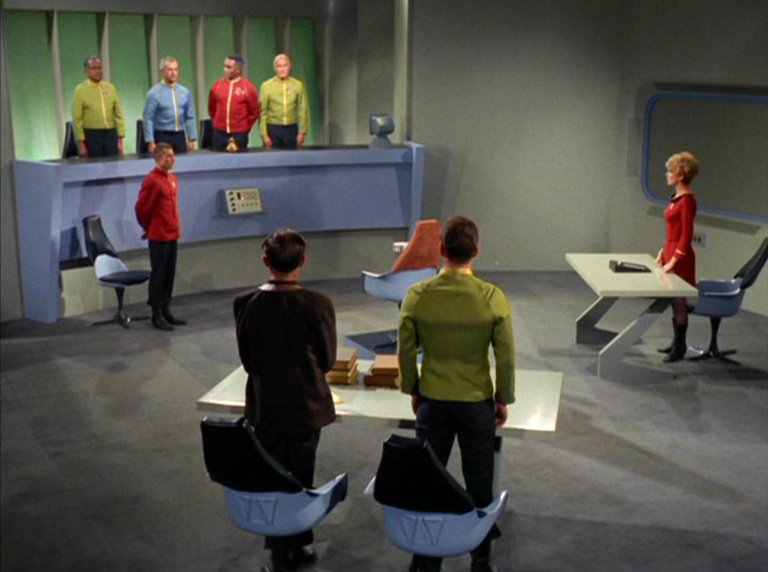Television Review: Court Martial (Star Trek, S1X15, 1967)

Court Martial (S01E15)
Airdate: February 2nd 1967
Written by: Don M. Mankiewicz & Steven M. Carabatos
Directed by: William Daniels
Running Time: 50 minutes
For dedicated Star Trek devotees, the early episodes of The Original Series (TOS) offer a tantalising glimpse into the birth of a cultural phenomenon. Yet, these formative instalments often feel uneven, with many struggling to match the sophistication of later seasons or spin-offs. However, a handful of canon-establishing episodes transcended these limitations, blending foundational worldbuilding with narrative depth. Court Martial, the episode of Season 1, stands out as one such rarity. It balances procedural drama with existential questions about trust in technology, offering a blueprint for the franchise’s enduring themes while occasionally succumbing to the era’s creative constraints.
The episode opens on the USS Enterprise docked at Starbase 1 for repairs following damage from an ion storm. Captain Kirk, however, faces a more pressing dilemma: the mysterious disappearance of Lt. Commander Finney (Richard Webb), the ship’s Records Officer, whose research pod was jettisoned during the storm on Kirk’s direct orders. Kirk defends his decision as a necessary sacrifice to save the ship, but Starfleet’s records contradict his account. This discrepancy leads to a court-martial, with Lt. Areel Shaw (Joan Marshall)—a former personal friend turned prosecutor—representing the prosecution. Commodore Stone (Percy Rodriguez), the Starbase commander and presiding officer, urges Kirk to resign to avoid severe punishment. Instead, Kirk retains his innocence and hires Samuel T. Cogley (Elisha Cooke, Jr.), an eccentric, book-loving lawyer who distrusts technology. The plot thickens when Spock discovers anomalies in the ship’s computer: during a 3D chess match, the computer suddenly underperforms its previous capabilities, suggesting tampering. This revelation undermines the prosecution’s key evidence, setting the stage for a climactic courtroom showdown.
Court Martial was conceived as a “bottle episode”—a cost-saving strategy relying on minimal sets and location changes. Co-writer Don M. Mankiewicz envisioned a tightly contained legal drama centred on the trial itself. However, production demands necessitated constructing additional Starbase sets, complicating the initial vision. Despite these logistical hurdles, the episode executes its premise seamlessly, offering a rare glimpse into the operational mechanics of the Star Trek universe. Notably, this is the first episode to explicitly name Starfleet and Starfleet Command, cementing the organisational structure that would become central to the franchise. The Starbase setting, though limited, feels functional and immersive, grounding the proceedings in a plausible future bureaucracy.
The episode’s real-world parallels are striking. The court-martial process mirrors modern military tribunals, while Starfleet’s internal politics echo contemporary organisational dynamics. Cogley, played with gruff charm by Elisha Cook Jr., embodies a Luddite resistance to technology—a theme Hollywood would later explore with greater urgency. Cook’s performance, steeped in Classic Hollywood character acting, adds gravitas to the role. His disdain for computerised systems feels both anachronistic and prescient, critiquing overreliance on technology even as it underscores humanity’s role in navigating ethical dilemmas.
Cogley’s technophobia resonates today, as modern society grapples with algorithmic bias and data manipulation. The episode’s central conflict—whether to trust fallible human judgment or infallible (yet corruptible) computer records—anticipates contemporary debates about AI’s role in justice systems. The revelation that Starfleet’s computer was tampered with to frame Kirk underscores a timeless warning: technology, when weaponised, can subvert truth and victimise the innocent. This tension remains eerily relevant in an era of deepfakes and algorithmic misinformation.
Despite its strengths, Court Martial is not flawless. Alice Rawlings’ portrayal of Finney’s daughter, Jame, is a glaring misstep. Her character oscillates between hysterical grief and unexplained forgiveness of Kirk, a narrative arc undercut by scenes edited out to meet runtime constraints. The abrupt tonal shift leaves her motivations muddled, diminishing the emotional stakes of Finney’s fate.
Yet this flaw are overshadowed by the episode’s technical and performative strengths. Director William F. Claxton (credited as William Daniels) maintains a steady rhythm, balancing claustrophobic courtroom tension with the Enterprise’s sleek visuals. The script’s dialogue, particularly during cross-examinations, crackles with wit and purpose, showcasing Shatner’s Kirk at his most commanding. William Shatner’s performance drips with self-assured authority, his charisma making Kirk’s defiance of Starfleet’s institutional overreach both compelling and believable. Spock and McCoy’s secondary roles, while underutilised, anchor the episode in its familiar trio dynamic. Costume design also merits praise, with Starbase officials sporting sleek, futuristic attire that blends 1960s futurism with military precision.
The finale delivers a modest but satisfying payoff, blending legal triumph with a burst of action as Kirk confronts Finney—a surviving, vengeful saboteur—on the Starbase’s surface. Though less explosive than later TOS action sequences, the resolution respects the episode’s grounded tone, prioritising cerebral stakes over spectacle.
Court Martial is a flawed yet fascinating milestone in Star Trek’s evolution. It establishes crucial lore while tackling themes that remain urgent today, all within the constraints of 1960s television. Shatner’s commanding presence and Cook’s nuanced lawyering elevate the material, compensating for weaker performances and uneven pacing. For fans and critics alike, it serves as a reminder that the franchise’s greatest strengths—its intellectual ambition and moral clarity—were present from the very beginning, even if they occasionally struggled to escape the era’s creative limitations.
RATING: 7/10 (+++)
Blog in Croatian https://draxblog.com
Blog in English https://draxreview.wordpress.com/
InLeo blog https://inleo.io/@drax.leo
InLeo: https://inleo.io/signup?referral=drax.leo
Hiveonboard: https://hiveonboard.com?ref=drax
Rising Star game: https://www.risingstargame.com?referrer=drax
1Inch: https://1inch.exchange/#/r/0x83823d8CCB74F828148258BB4457642124b1328e
BTC donations: 1EWxiMiP6iiG9rger3NuUSd6HByaxQWafG
ETH donations: 0xB305F144323b99e6f8b1d66f5D7DE78B498C32A7
BCH donations: qpvxw0jax79lhmvlgcldkzpqanf03r9cjv8y6gtmk9